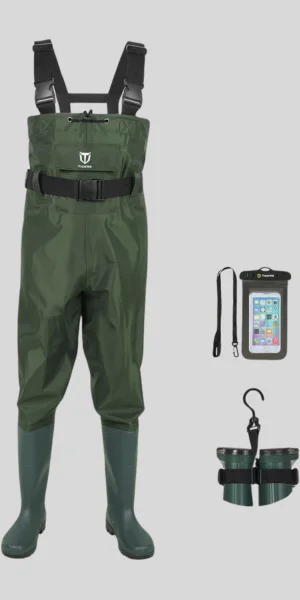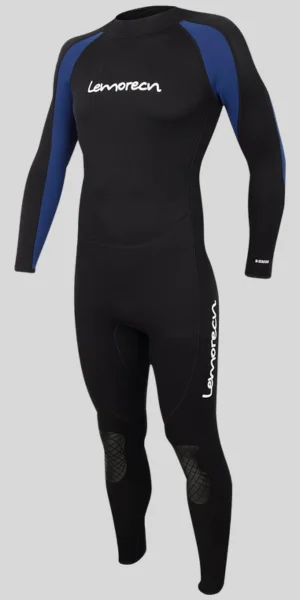Do you know the difference between Waders Vs Wetsuits? Most people don’t, and I was one of them until recently. In this blog post, I will explain the difference between the two, so you can make an informed decision next time you go fishing or swimming.
Spoiler alert: wetsuits are better for swimming, but waders are better for fishing! Keep reading to find out why.
Key Difference Between Waders Vs Wetsuits:
Waders Vs Wetsuits Material Comparison:
When considering waders or wetsuits, it is important to look at the material each is made with. Generally, waders are constructed using neoprene and nylon, while most wetsuits are made of neoprene. Neoprene offers greater warmth and protection than nylon, making it an ideal choice for cold weather settings.
Some higher-end models may also be constructed from a combination of different materials, such as polypropylene and Kevlar. The thickness of the material used also needs to be considered when choosing between waders and wetsuits.
Waders Vs Wetsuits Breathability Comparison:
The breathability of a wader or wetsuit is an important factor to consider. Breathability refers to how much air and moisture can pass through the fabric, allowing your body’sbody’s heat to escape. Waders are typically made of neoprene, which allows for some breathability but not as much as other materials like nylon and polyester.
Wetsuits have better breathability than waders because they are designed with many tiny air pockets between the layers of fabric that allow air and moisture to pass freely.
Waders Vs Wetsuits Durability Comparison:
Waders are made of much more durable material than a traditional wetsuit. The material used in most waders can withstand extensive wear and tear, making them perfect for long-term use. Wetsuits are generally made of thin neoprene material and can easily be damaged or torn.
Wetsuits often need to be replaced more frequently due to their lighter construction and frequent exposure to water. Waders are the better option if you are looking for something with long-lasting durability.
Waders Vs Wetsuits Comfortable Comparison:
Waders are much more comfortable to wear than wetsuits. Some wetsuits can be tight and restrictive, making it hard to move around freely or even breathe properly. Waders are loose and lightweight, so you won’twon’t feel weighed down or restricted in any way.
It makes them perfect for fishing, where you must move your legs a lot. Some waders have built-in insulation that helps keep you warm in cold water environments.
Waders Vs Wetsuits Design Comparison:
Design is a key factor when choosing between waders and a wetsuit. Waders are designed to be waterproof and come in a variety of styles, from breathable neoprene to rubber-coated nylon. They are also lightweight and flexible, making them ideal for anglers who want mobility while fishing.
Depending on the environment and temperature, waders may also include built-in insulation to keep you warm. Wetsuits are made of thicker materials such as neoprene and offer greater protection than waders.
Waders Vs Wetsuits Storage Features Comparison:
When it comes to storage features, both waders, and wetsuits offer very different experiences. Waders have the advantage of being able to be rolled up tightly for convenient transport and storage. Wetsuits are made from neoprene or other synthetic materials that can be easily folded or compressed;
they must be hung up in a designated area where they won’t come into contact with sharp objects or rough surfaces, so while waders may take up less space when not in use, wetsuits generally offer more protection from damage during transport and storage.
Waders Vs Wetsuits Waterproofing Comparison:
When it comes to staying warm and dry in the water, waders and wetsuits, provide excellent waterproofing. Waders are made from a lightweight material such as nylon or polyester coated with a waterproof rubber layer. It creates an outer shell that is quite effective at repelling water.
It does not offer much warmth. A wetsuit uses neoprene as its main material. The thick neoprene works well for trapping heat inside the suit and creating an effective barrier against cold water.
Waders Review:
Waders are waterproof items of clothing designed to keep the feet and legs dry when walking in wet areas such as marshes, wetlands, streams, or rivers. They come in various styles, including chest waders, hip waders, and waist-high waders. Some feature neoprene construction which provides extra insulation from chilly waters. Waders also typically have adjustable straps for a snug fit and reinforced boots for greater durability.
When it comes to selecting the right pair of waders, many things should be taken into consideration. Choosing a style that best meets your needs and fits is important to ensure maximum performance when on the water. Breathability is also essential for comfort and temperature regulation during long trips.
Wetsuits Review:
The right wetsuit can make all the difference in enjoying your time in the water. Whether you’re a recreational snorkeler, a professional freediver, or an avid surfer, having the right gear is essential. To help you find the perfect fit, we’ve put together this comprehensive wetsuit review to guide you through all of your options and ensure you have everything you need to stay comfortable and safe in the ocean.
Wetsuits are made of neoprene fabric, providing insulation and buoyancy while protecting against cold temperatures and abrasion. It’sIt’s important to choose a style that fits so you can move freely and comfortably in the water without sacrificing safety.
Conclusion:
You have a few options when choosing the right gear for your water activities. Waders and wetsuits provide excellent waterproofing, with waders offering lightweight protection from wet environments and wetsuits providing warmth and buoyancy in cold waters.
The choice will come down to your budget, intended use of the gear, and comfort preferences when deciding which type is best for you. This guide has provided enough information to help you make an informed decision.
FAQs:
Can you wear a wetsuit under a dry suit?
Yes, you can wear a wetsuit underneath your dry suit. Wearing a wetsuit under a dry suit is often done to enhance warmth and insulation. Ensuring the two garments are properly fitted and sized for optimal comfort and performance is important.
An ill-fitting wetsuit or dry suit can create uncomfortable pressure spots, restrict movement, and even cause rashes or abrasions. It also helps to layer other thermal protection items, such as liners and base layers, underneath the drysuit and on top of the wetsuit.
Why do people wear waders?
Waders are essential clothing items for anyone who spends much time in or near water. They protect you from the cold and wet while allowing you to stay dry and comfortable. Waders are made from waterproof fabric and are designed to be worn over other clothing, such as shorts and wicking base layers.
They’re an excellent choice when fishing, hunting, boating, kayaking, or participating in any other activity that requires you to be partially submerged in water.
Are waders fully waterproof?
When it comes to staying dry, waders are your best bet. Waders are designed for wet conditions and are made from highly waterproof materials. However, there is no such thing as a completely waterproof wader. All waders have seams and sections allowing water to enter in certain circumstances. The effectiveness of waders depends on the quality of construction and the care taken when using them.
Do waders keep you warm?
Yes, waders do keep you warm. Waders are waterproof clothing that covers your legs and feet, usually rubber or neoprene. They are designed to let you walk in streams, rivers, and lakes without getting wet and cold.
The materials used to make waders act as insulators by trapping air between the fabric layers, creating a barrier against the cold water. This insulation helps to keep your body heat from dissipating into the water while also slowing down convection currents that can cause heat loss.
What is the difference between a wetsuit and a dry suit?
A wetsuit is designed to keep you warm in the water by trapping a thin layer of water between your skin and the suit, which is then heated up by body heat. It makes it great for swimming and diving in cold waters. A dry suit does not let any water inside its layers. Instead, it uses air trapped between its two layers to insulate you from the cold.
Dry suits are ideal for activities done in very cold temperatures, including ice diving or sailing in frigid waters. They also protect you from sharp rocks or coral that would damage a wetsuit if contact was made.
Do waders keep you dry?
Yes! Waders are designed to keep you dry while fishing or hunting. They consist of two layers of waterproof material, often rubber or neoprene, which wraps around your feet and legs like pants. The outer layer repels water, while the inner layer helps to insulate your body heat in cold weather.
Many waders also have built-in boots with traction outsoles to help you stay safe while traversing slippery terrain. With properly sized waders and good insulation, you can enjoy hours out on the water without getting wet or cold.


